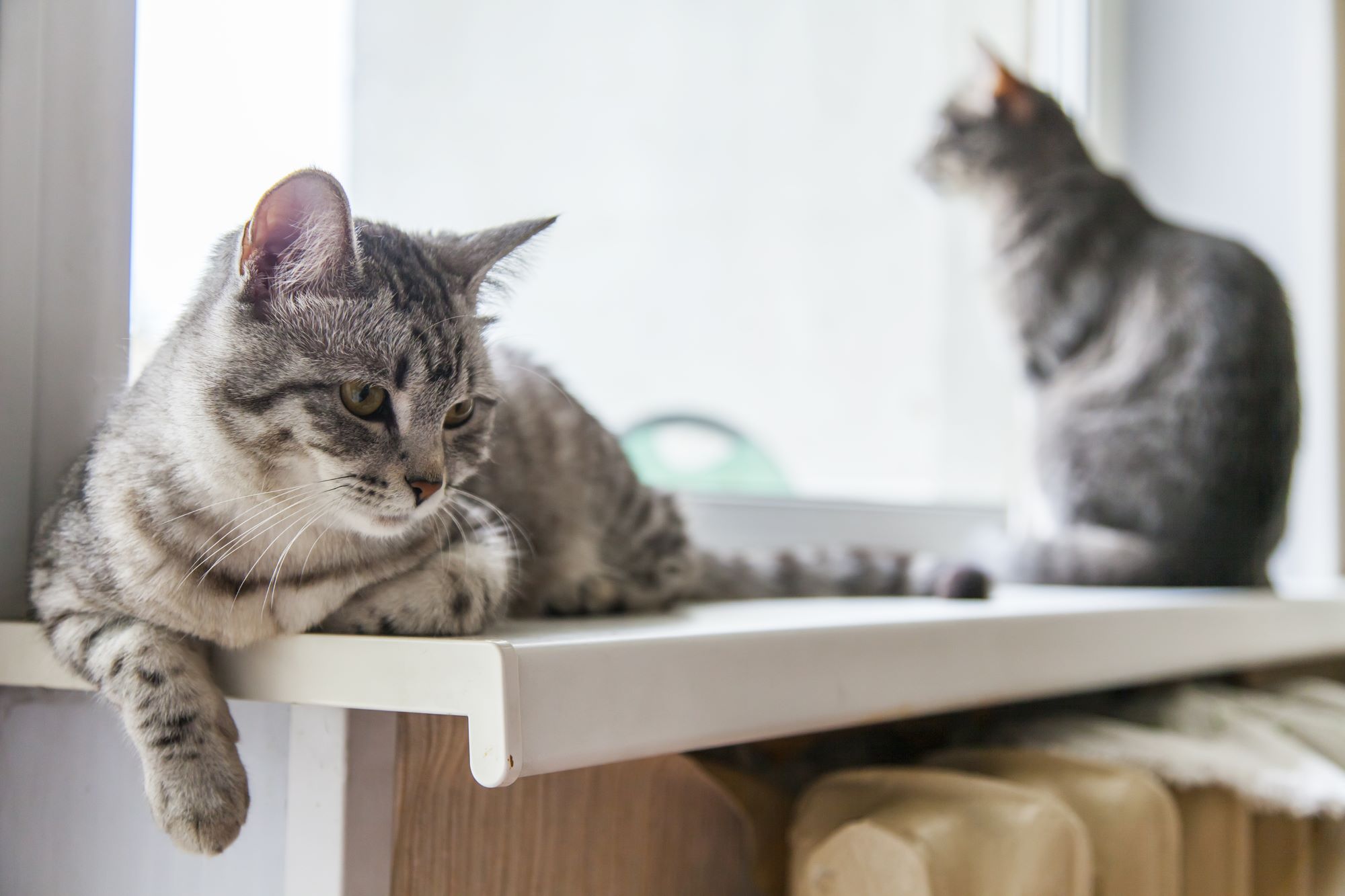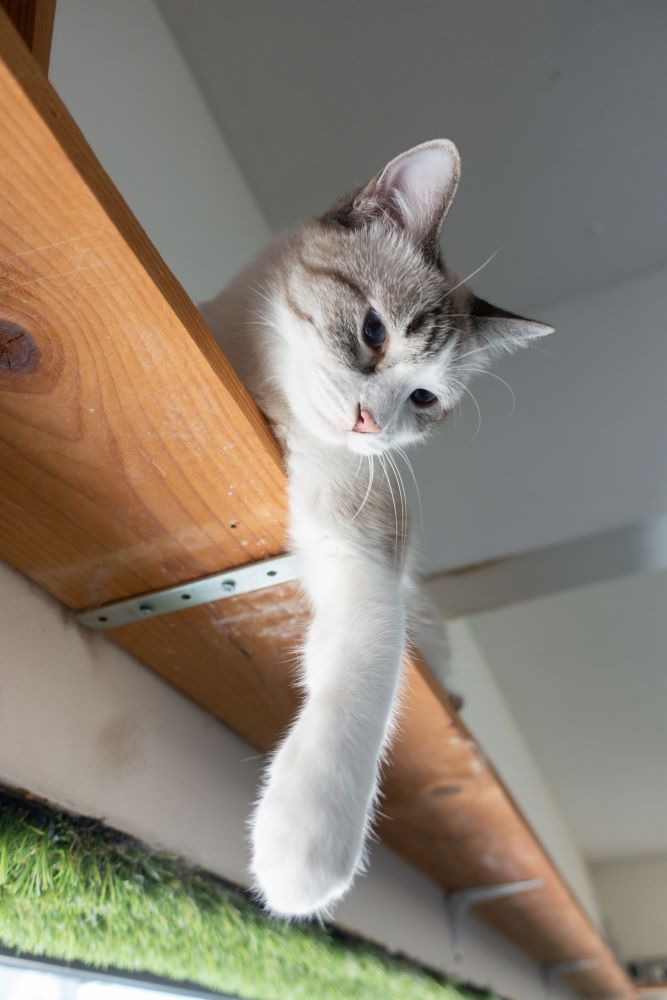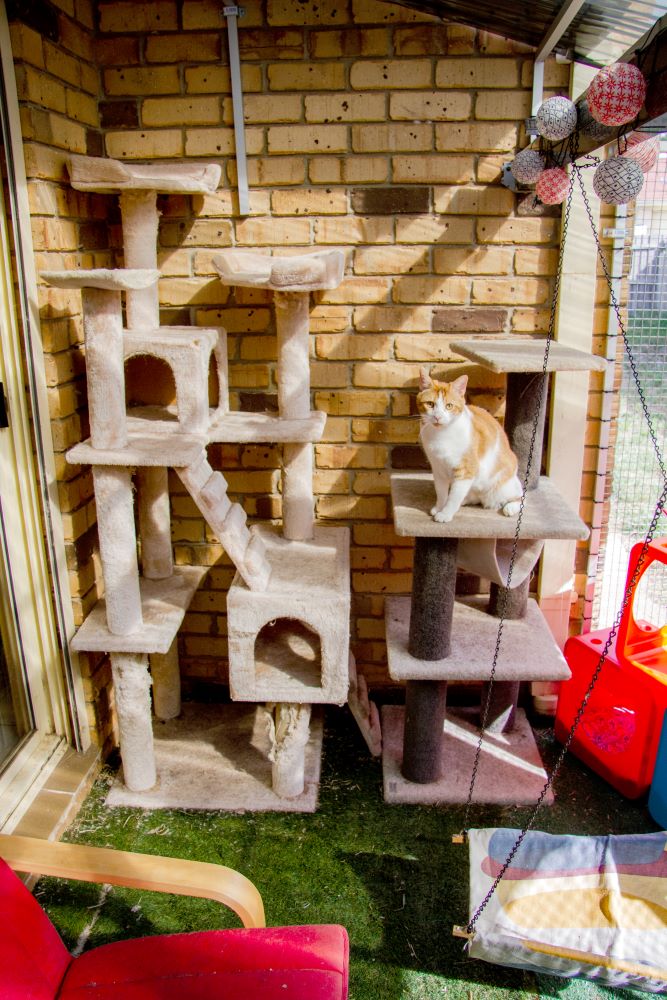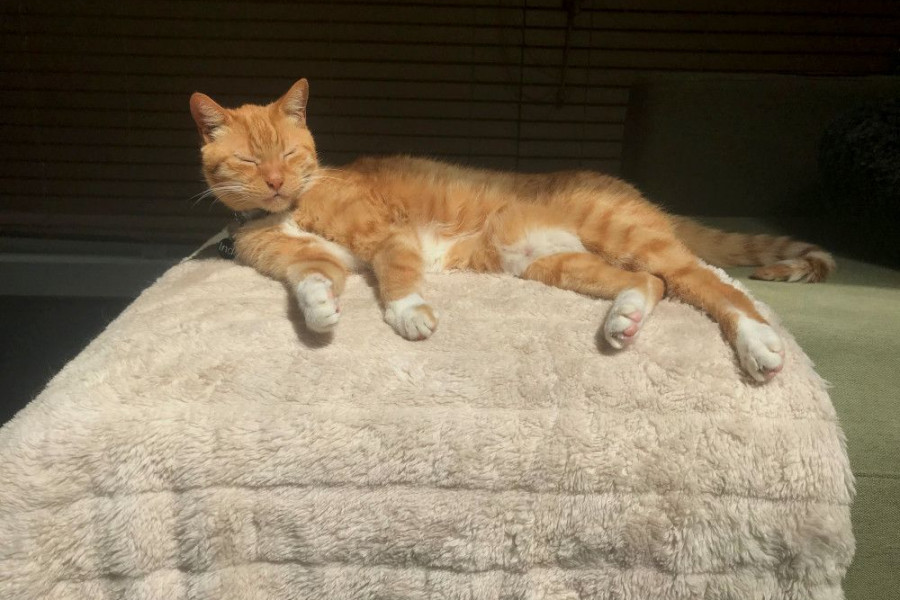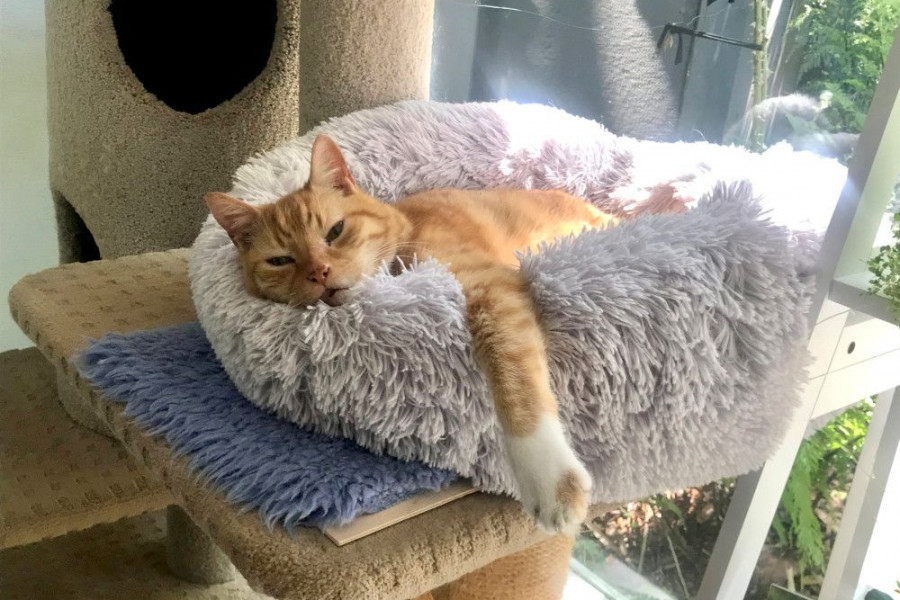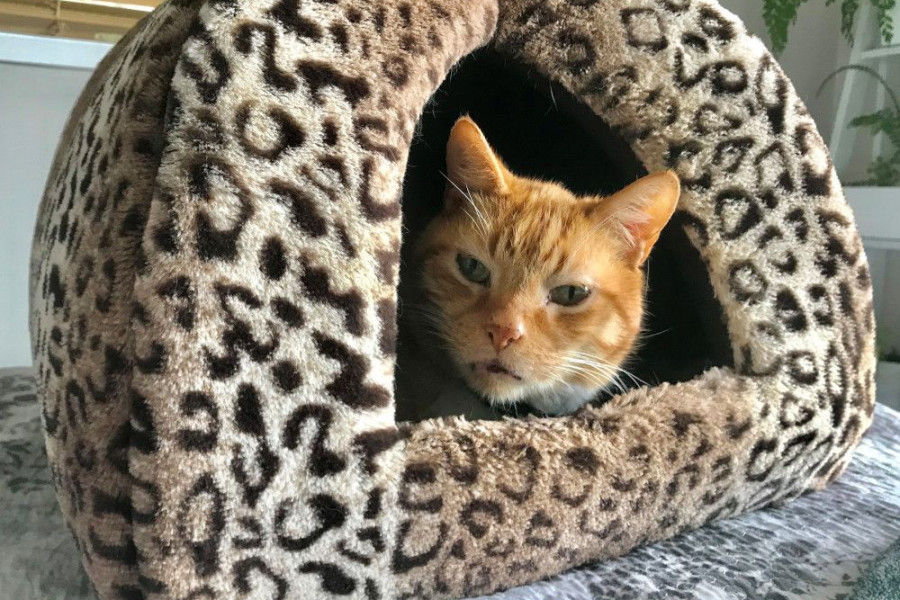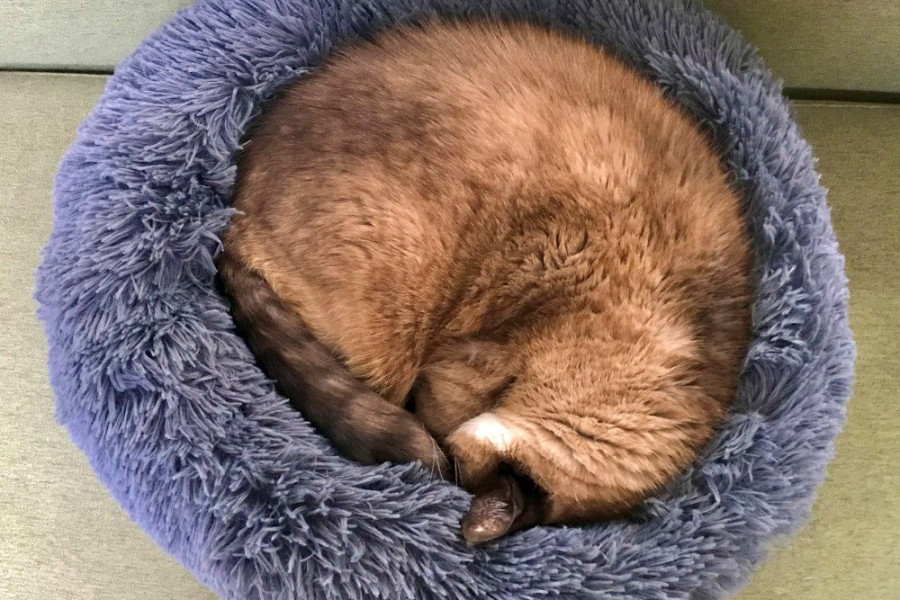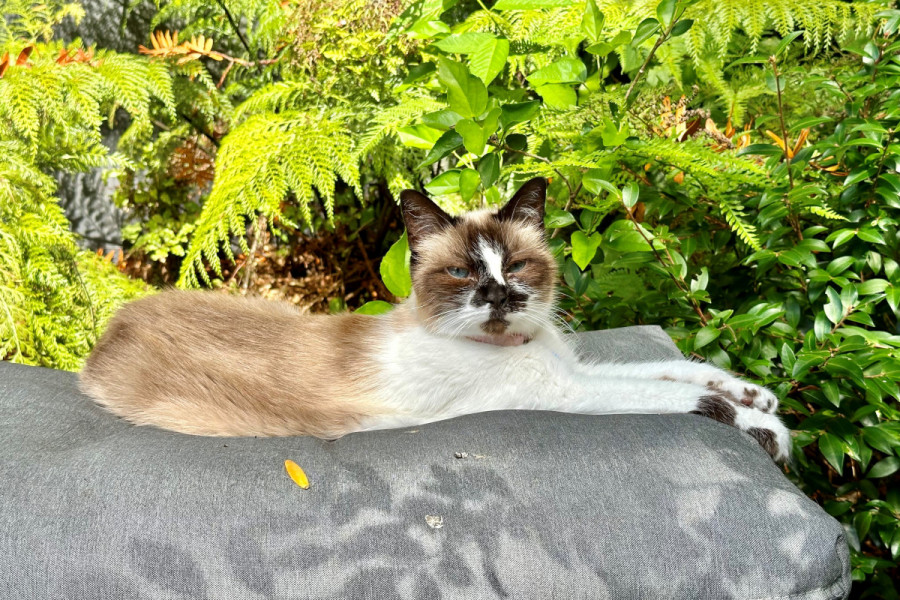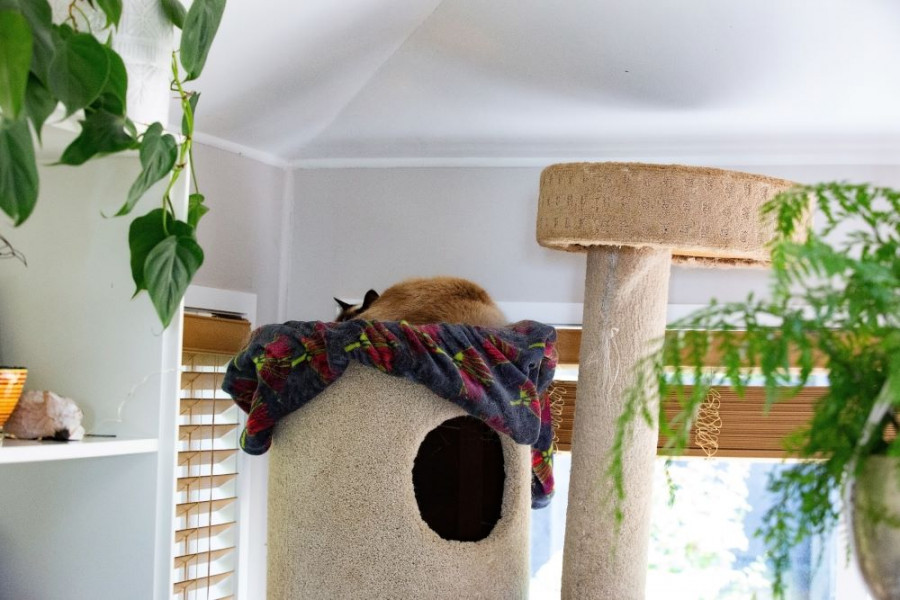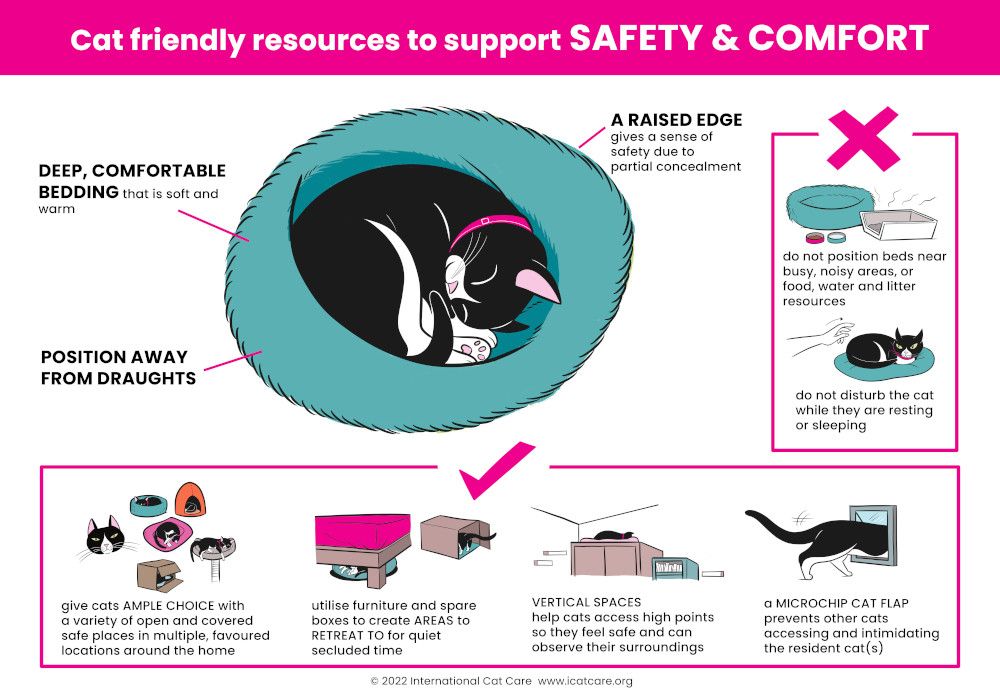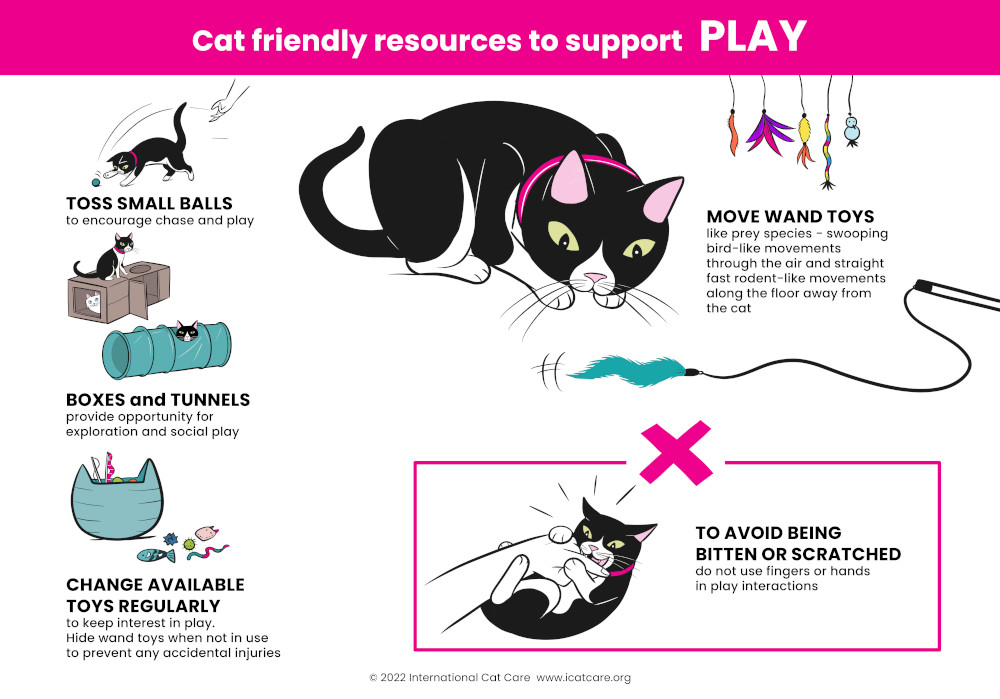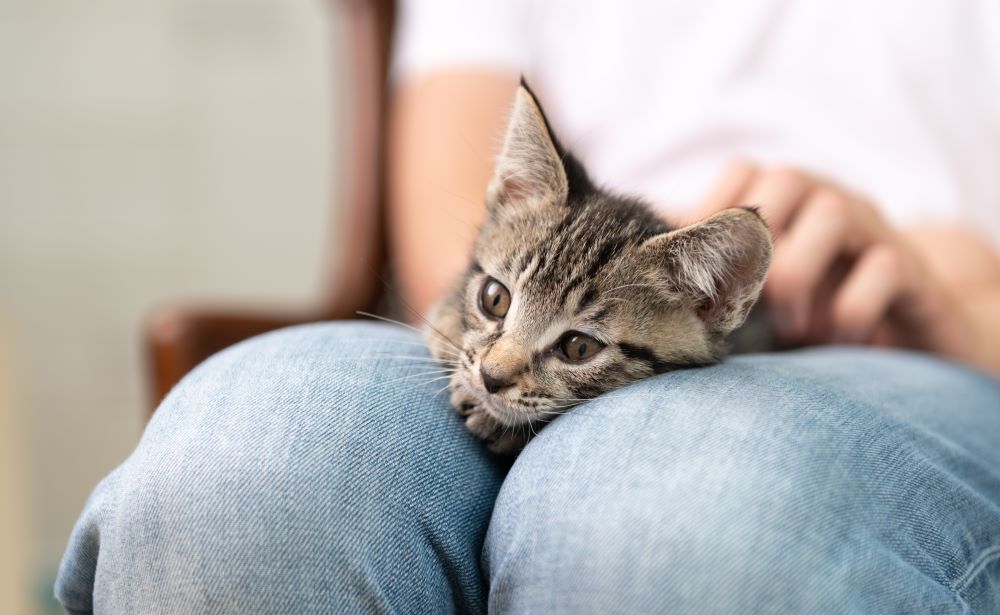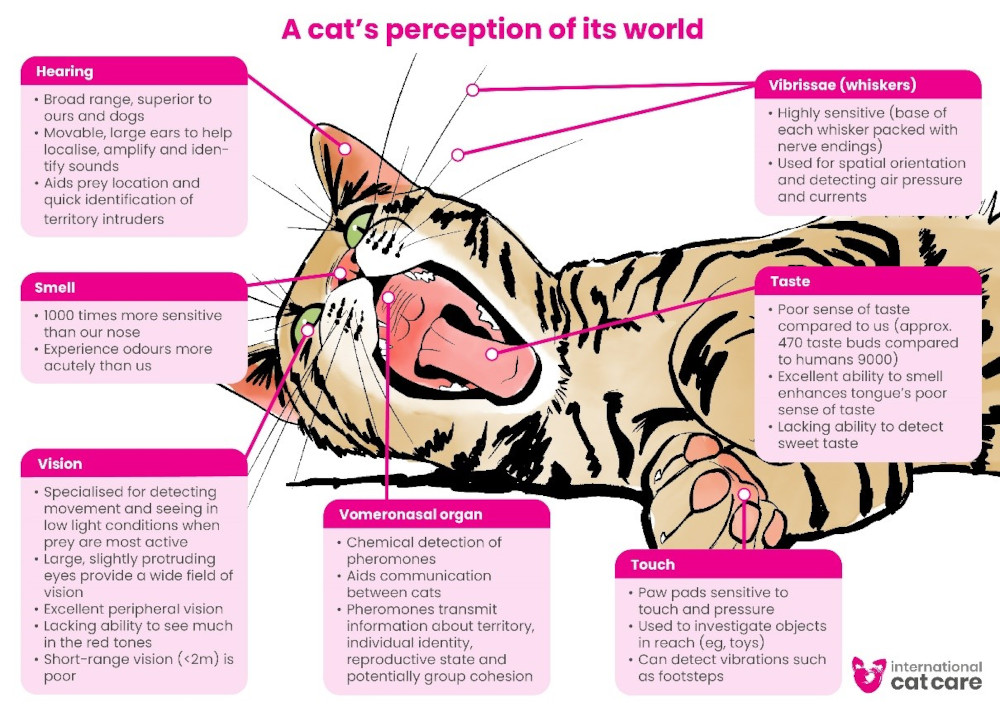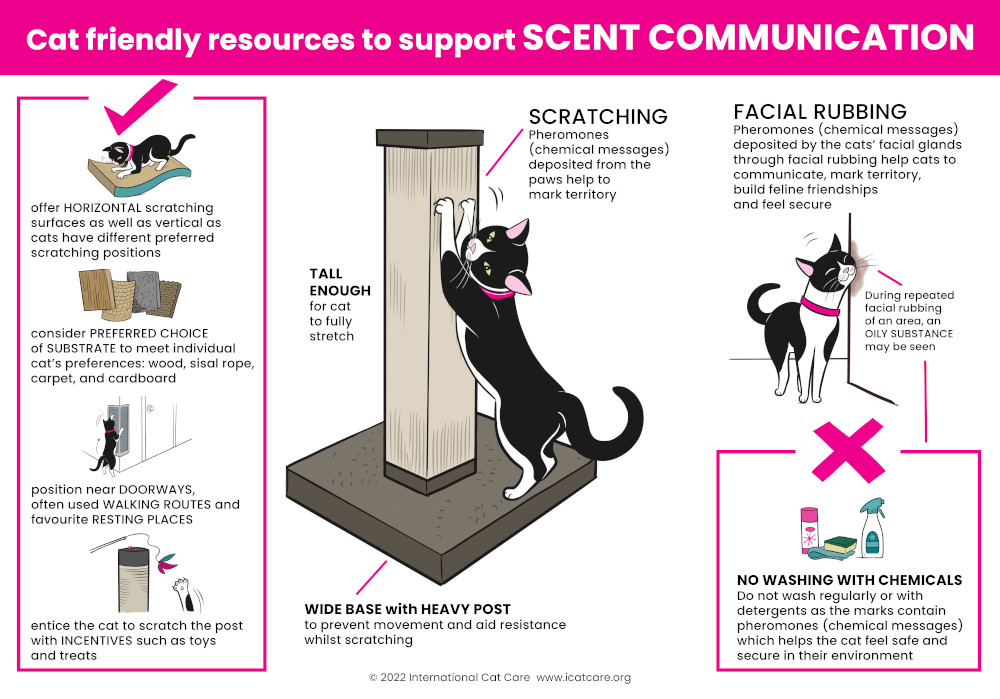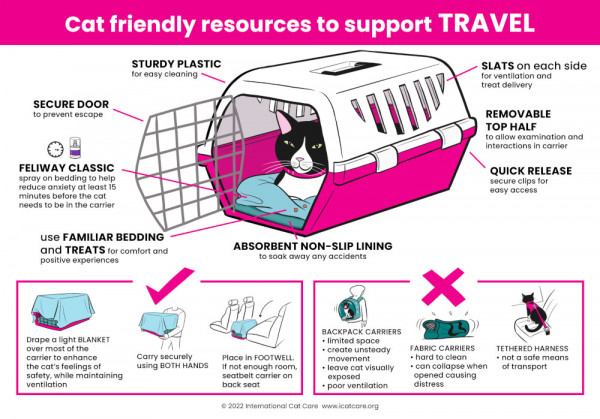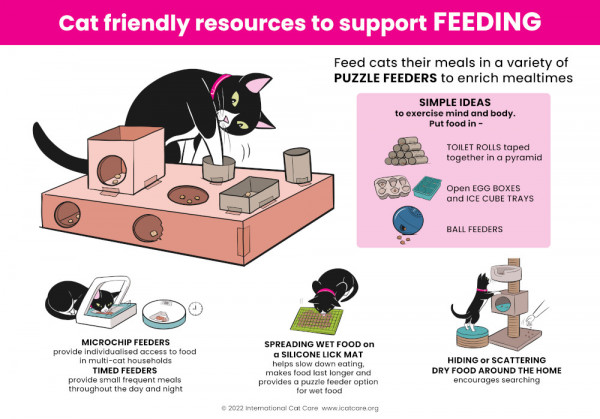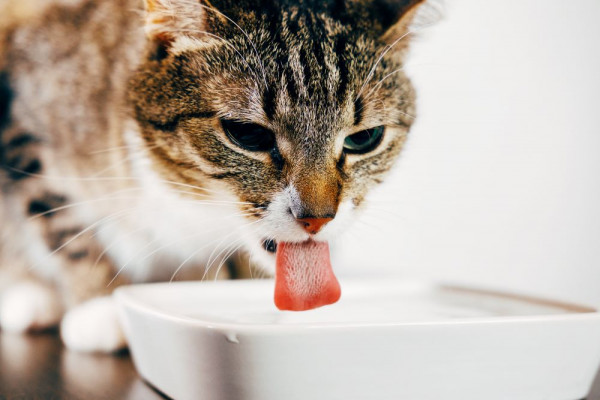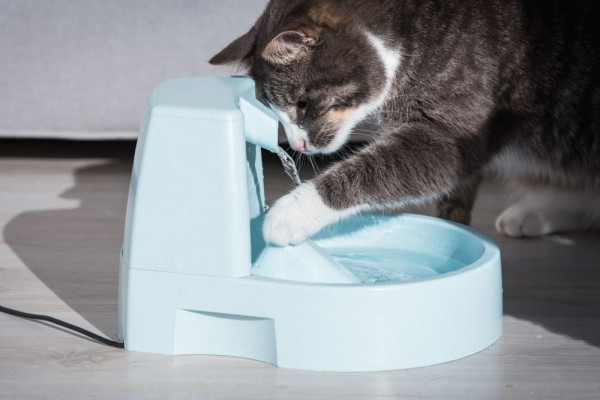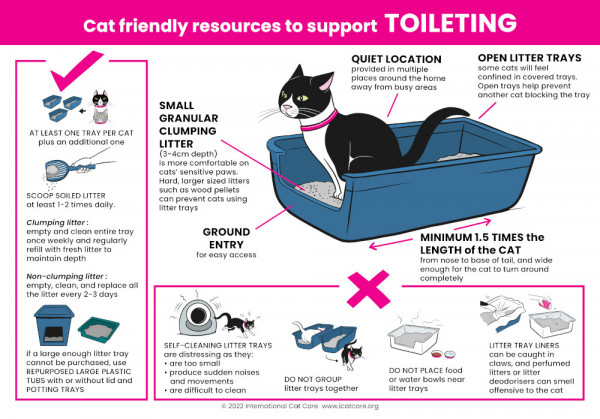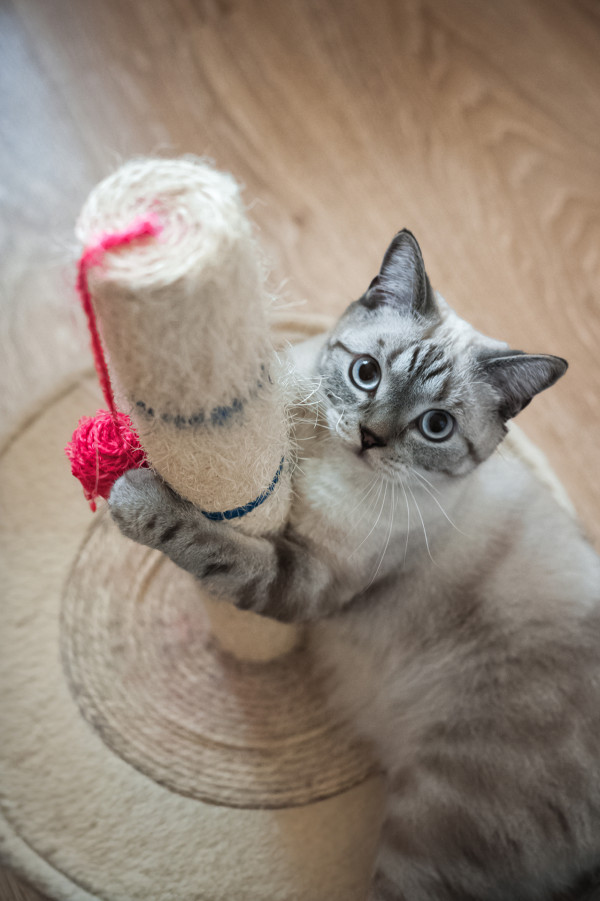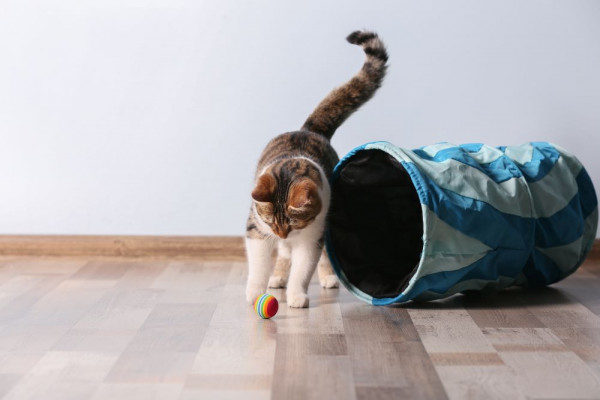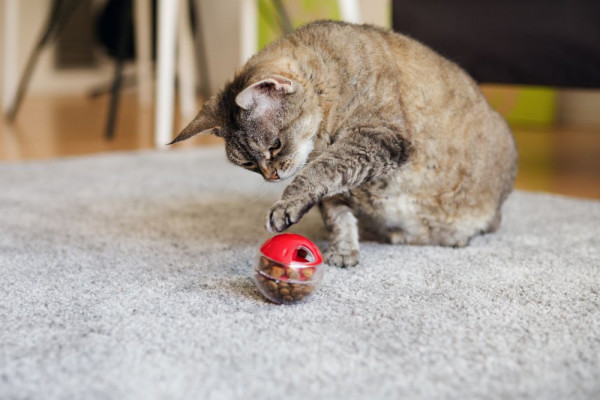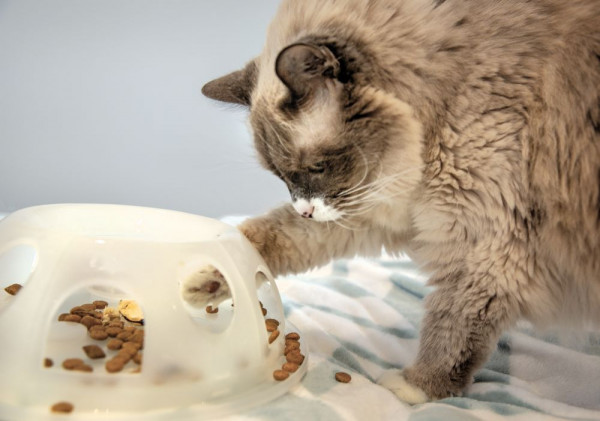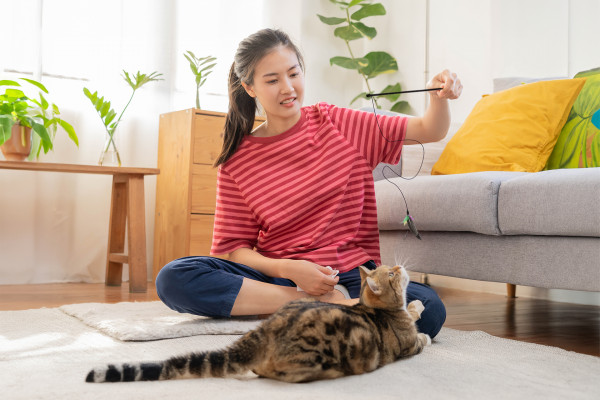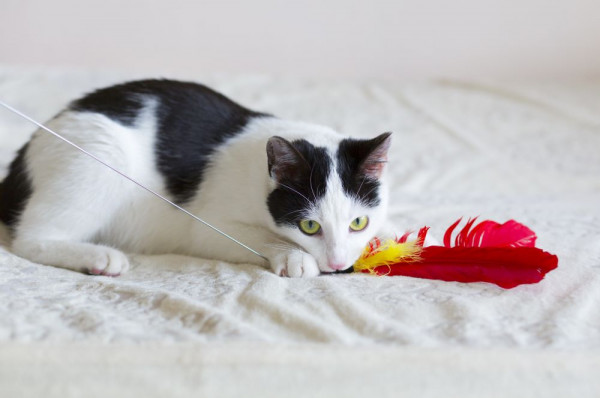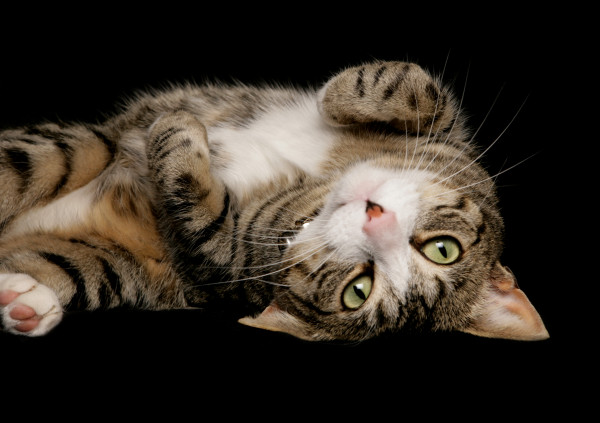Home

Thank you for providing a loving home for your feline friend!
Whether you’ve just adopted a new cat or kitten or are considering how best to care for your existing cat, this guide is for you. We know that cats can be safe and happy at home, avoiding the dangers of roaming. Many owners provide a safe environment that promotes positive wellbeing for their cat at home all day, every day.
The information in this guide can assist anyone who wants to optimise their cat's wellbeing, regardless of your cat's lifestyle.
Keeping your cat safe at home is important. Cats who are safely contained at home are at less risk (e.g., they are less likely to be injured by cars, other cats, dogs, and other animals).
Keeping your cat happy at home means providing for all their needs, including some that may previously have been met by roaming outdoors.
Meeting these needs in other ways requires forward thinking and a little imagination and commitment. But you needn’t go it alone; we’re here to help explain how you and your cat can live at home together in harmony.
Safer at home
don’t let me roam
What is cat containment?
Containing your cat means keeping them within your property boundaries all of the time and preventing them roaming from your property at any time, day or night — in other words, keeping your cat safe at home and not letting them roam.
Contained cats do not have to live totally indoors. Access to a safe outdoor escape-proof enclosure or fenced garden is highly recommended as this greatly assists in providing an environment that meets your cat’s physical and mental needs, including increasing the opportunity for activity and stimulation by allowing them to experience the benefits of the outdoors without the dangers of roaming beyond their home property boundaries.
Why should I keep my cat contained?
By keeping your cat safe at home, you will be:
What are the risks of roaming?
Keeping your cat at home helps reduce their risk of disease, injury, or death from:
What do I need to know about my cat’s behaviour and needs?
To help provide them with the best life possible, it’s important to understand your cat on a more fundamental level, how they communicate with humans and other cats, and how to provide opportunities for each individual cat to have positive experiences.
We’ve provided a guide to cats' behaviour, emotions, and communication – so if you want to understand a little more about how your feline friend thinks and feels, read on.
Will my cat be happy staying at home?
Cats can be very happy staying at home if they have an environment that safeguards their physical and mental health and provides them with the opportunity for positive experiences and good welfare.
Your newly adopted cat may be more likely adapt to a stay-at-home lifestyle if you keep them at home from the beginning. Newly adopted cats should always be contained during the settling-in period anyway, as they may be more likely to run off or become lost if allowed to roam outside when they have not yet settled in.
Kittens generally cope well with a totally stay-at-home lifestyle if their environment meets their needs, and they are used to this from an early age.
If you have an existing cat who roams, it may be possible to successfully transition them to a stay-at-home lifestyle, depending on the individual. It is important to try to introduce them to staying at home on your property gradually as this is a big change for them (e.g., you may start by gradually getting them used to staying home at night and then slowly increasing the time they are contained to your property, only making a change if they have adapted to the previous changes). It is essential to provide an environment that meets their needs and is a place that they enjoy being (this means making sure they have choice, control, and challenges at home, including plenty of opportunities to explore and display predatory play behaviour using a variety of toys and regular positive play sessions every day).
Ideally, all cats should have access to a safe and secure outdoor area, but this may be particularly important to help cats who have been used to roaming outdoors adjust to a stay-at-home lifestyle.
Although many cats are very happy staying at home, some cats may not be compatible with this lifestyle. If your cat does not seem to be coping well with a stay-at-home lifestyle, seek advice from your veterinarian and possibly a veterinary behaviourist.
How do I keep my cat at home?
These are the main options for keeping your cat contained:
Extending your cat's indoor environment with a fully enclosed secure outdoor area is a great way to give your cat a complex and interesting environment with lots of choice as well as helping to keep them safe. This option fully encloses an outdoor space for your cat such as an area of your garden, balcony, courtyard, or patio by using a barrier such as net, wire, or solid material to secure all the potential exit points (to the sides and, potentially, overhead).
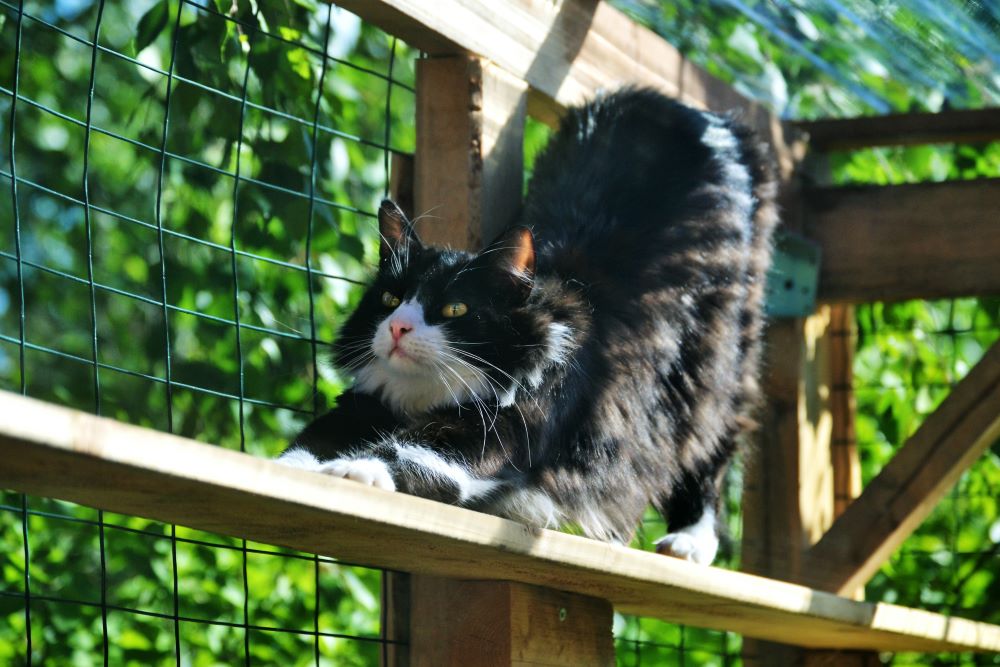
Example of a garden cat enclosure (made using wire and wood) that is attached to the house and contains platforms and walkways.
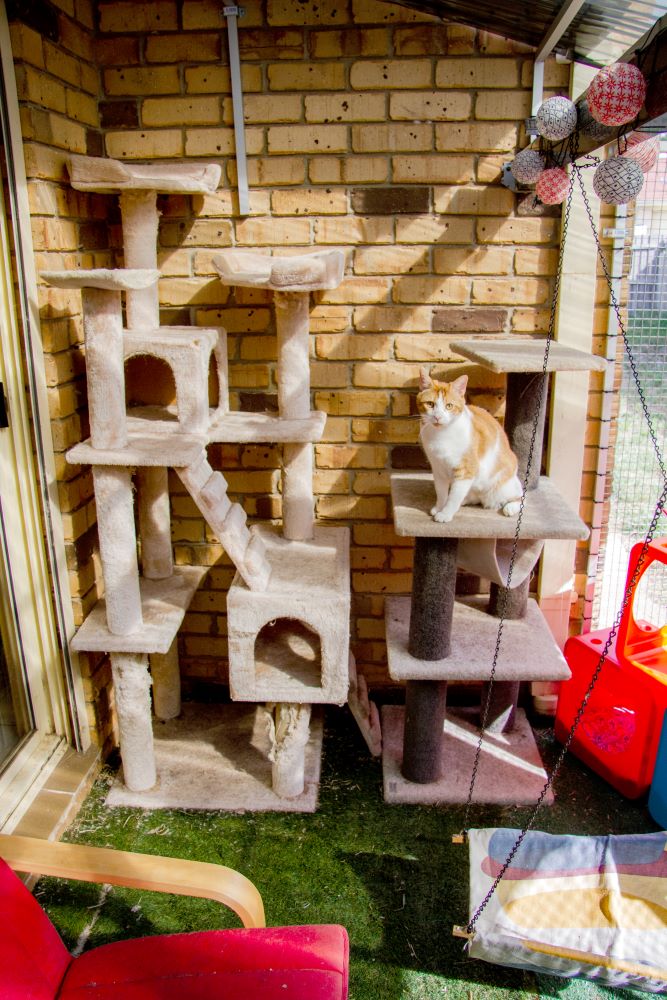
Example of an enclosed patio cat enclosure (using netting) that is attached to the house and contains cat towers, multiple levels, and places to observe, rest, sleep, and hide.
Make sure the enclosure is both escape-proof (to stop your cat getting out) and animal-proof (to prevent other animals getting in). The enclosure should be attached to your cat’s indoor space via a cat flap (or a window or door that can be left open), so that your cat has free and immediate access in and out of the indoor/outdoor spaces.
Having your cat’s outdoor space linked to the indoors is important as it means your cat can choose where they spend their time. They can retreat into the house if something outside scares them, and there is less risk of accidental escape than if you are moving them into a separate enclosure. If you have a balcony or veranda which can be made escape-proof, this is another option.
To avoid your cat dashing through a door or gate and escaping, it can be helpful to create a double door or gate system at the external exit point(s) to your cat's outdoor area. This means that at the exit point you open one gate (or door), enter this space, then close the first gate and check to make sure your cat has not come through before opening the next gate. See example below:
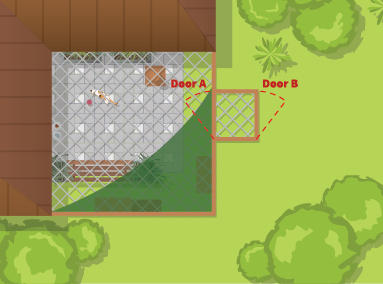
If your only option is to have a freestanding enclosure, it is strongly recommended that this is connected to the house. You can do this with by connecting the freestanding enclosure to the house (or a part of the house) with a tunnel and cat flap for safety, social connection, and welfare considerations. That way the cat can choose to be inside or in their enclosure whenever they want and wherever they feel safest, happiest, and most comfortable.
A freestanding enclosure that is not connected to the house is not recommended as this option does not give your cat choice about when to use the enclosure or be inside, and there are also potential safety and comfort related issues with this option. For example, it can be difficult to provide an environment that can be kept at a comfortable temperature in a freestanding enclosure. Ensuring that it does not get too hot or cold is an important consideration as the cat will not have the choice to move to another area to help regulate their temperature.
Extending your cat's indoor environment with an outdoor space in your yard or garden that is surrounded by an escape-proof and animal-proof barrier will help to keep your cat safe and give them a complex and interesting environment with lots of choice.
There are plenty of ideas and products available to help you make your yard or garden escape-proof, such as a modified fence or netting.
For more information see the Cat-proofing tips section below.
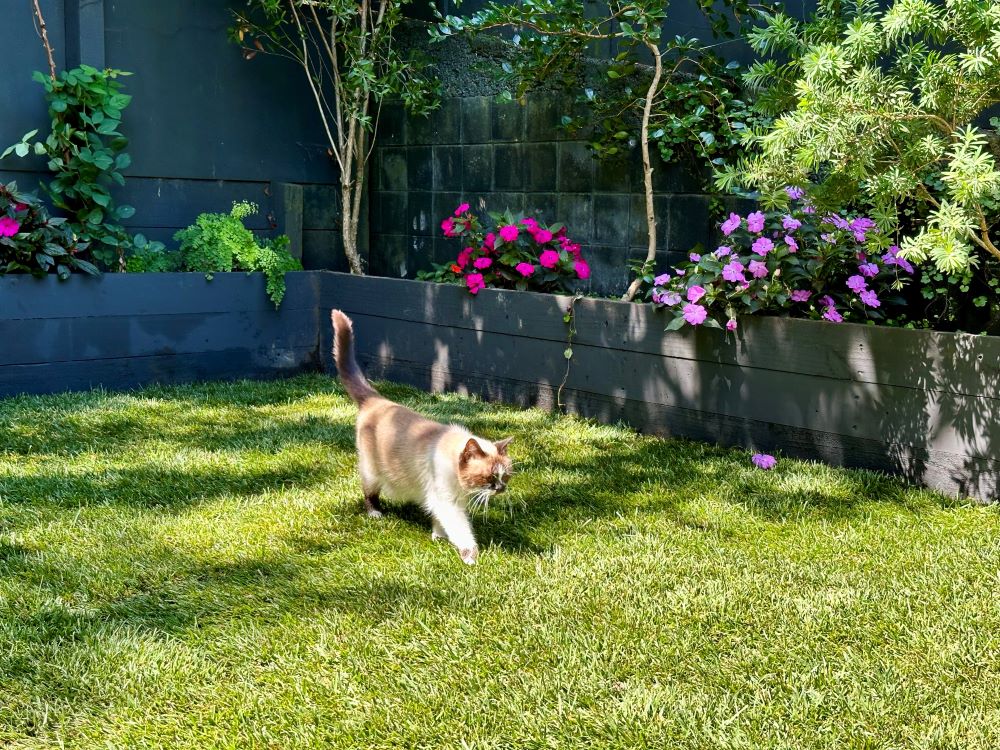
Enclosed garden secured using existing fencing with rollers on the top (connected to the indoors via a cat flap for free access).
This can work well when you provide for all your cat's needs within your home. That means providing enough space, and lots of mental and physical enrichment for your cat - including consistent, predictable, and positive interactions with people - and multiple and separated areas for eating, drinking, sleeping, hiding, toileting, scratching, and playing.
To help your indoor cat benefit from exposure to outdoor sights, smells, and sounds, you can install cat-proof screens so that windows and doors can be opened without your cat escaping.
Cat-proofing a backyard with cat-proof fencing
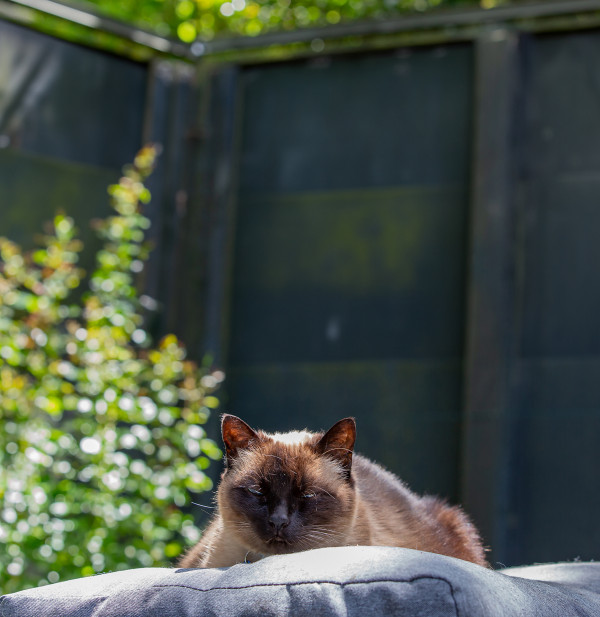
The photo above/right shows an example of a garden enclosed with rollers on the top of existing fencing to make it cat proof.
If you have an existing continuous solid fence around your backyard, you can modify the top of the fence to stop your cat gaining purchase and climbing over to escape. You can achieve this using rolling cylinders, smooth metal or plastic sheeting, or inward-inclined wire. Please note that inward-inclined wire or smooth sheeting just on the inside of your fence will not prevent other cats coming into your garden. To stop this, you will need to install rolling cylinders, or use inclined wire or smooth sheeting on both sides of the fence.
Alternatively, you can erect a new solid fence with an escape-proof top to create a secure space.
A cat-proof fence should have a total height (including any extension/escape-proof top) of at least two metres, or your cat may jump over it.
Don’t forget to check for anything that might lead to an escape, such as gaps in the fence, around gates, where the fence meets the building or overhanging trees and tree trunks near the property boundary. Check the escape-proofing regularly to make sure that it remains safe and secure.
If you have any trees close to the fence, a simple way to stop cats climbing them is to fix a smooth metal or plastic band around the trunk at least two metres off the ground.
Using netting for cat proofing
Cat-proof netting can be used to provide a secure outdoor space in a backyard, balcony, courtyard, or patio. The netting should be floppy (but not stretchy) to discourage climbing. To avoid your cat getting their paws, claws, or even their head caught in the net, the openings should be about 50mm wide. Young kittens should be kept away from netting until they are close to adult size.
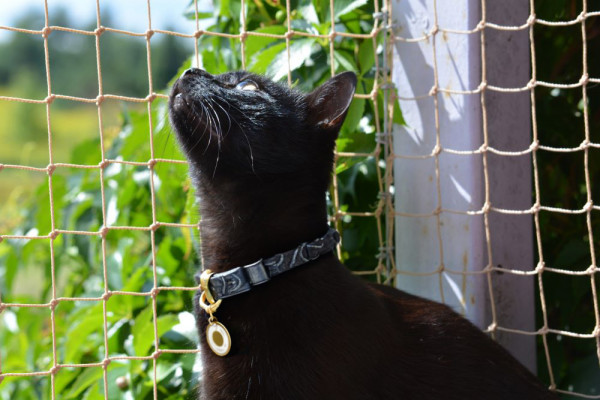
If a net extension is being added to an existing fence, the total height needs to be at least two metres, or your cat may jump over it.
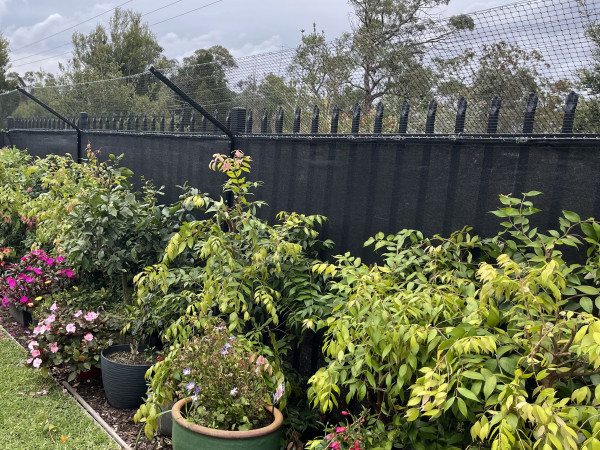
Example of a netting extension to an existing fence to make a cat-proof safe enclosed outdoor space.
Keep the net in good condition by reinforcing it along attachment points and making sure it can’t be chewed. Check it regularly to make sure that it remains safe and secure.
Other considerations for cats with secure outdoor spaces
Note that a cat contained in a backyard or enclosure may still kill or injure wildlife if they enter the cat’s space. You can reduce this risk by fitting an effective and humane predation deterrent collar with quick release on your cat (for an example, see image and details below) and making sure the enclosed area does not contain plants, food, or water sources that would attract wildlife.
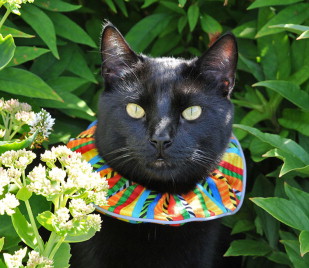
Willson SK, Okunlola IA, Novak JA (2015) Birds be safe: Can a novel cat collar reduce avian mortality by domestic cats (Felis catus)? Glob Ecol Conserv. https://doi.org/10.1016/j.gecco.2015.01.004
In addition, you still need to be aware of and take steps to reduce risks that your cat might face even in a cat-proofed garden or enclosure, such as snakes, ticks, other predators, and ill-intentioned people.
Cat proofing a balcony, courtyard, veranda, or patio
Cat-proof netting (or wire) can be used to provide a secure outdoor space in a balcony, courtyard, veranda, or patio. Just ensure that any exit points are cat-proofed – this includes any gaps between the balcony fence and the house (such as between rails, between the fence and the walls, and between the fence and the roof).
You can also enclose a small backyard or courtyard by covering the top (fence to fence/wall to wall) with netting/wire or extending your fence height with netting/wire. Netting should be floppy (but not stretchy) to discourage climbing. In the case of enclosing a balcony or veranda, rigid netting or wire can be used if the top of the balcony or veranda is cat-proofed or fully enclosed (e.g., with the roof).
Creating an optimal environment for your cat in their outdoor space (e.g., (enclosure/enclosed garden) is just as important as for their indoor environment.
As well as being safe and secure, it is important that their outdoor space also feels safe and secure to your cat. Also, the more appealing the outdoor space is, the more like your cat is to enjoy it and want to use it.
You can use the five pillars of a healthy feline environment explained below to create an outdoor environment that meets your cat's mental and physical needs and enriches their life.
For example, you can create an outdoor space for your cat that:
- Is a safe place (i.e., it is safe and secure and feels safe and secure with resting and hiding places, a variety of elevated platforms at different heights, and adequate protection from the weather [e.g., sun, rain, wind] and extremes of heat and cold).
- Contains multiple and separated key environmental resources (e.g., drinking stations, places to scratch, opportunities to play, and areas to sleep and rest).
- Provides opportunity for play and predatory behaviour (e.g., provide toys and play time outdoors as well as indoors).
- Facilitates positive, consistent, and predictable human-cat social interaction (e.g., spend quality time allowing your cat to interact with you in ways they enjoy in their outdoor space).
- Is an environment that respects the importance of the cat’s sense of smell and other senses (e.g., consider the impacts of the outdoor environment on your cat’s senses [smell, sight, hearing, touch, and taste] and try to avoid or minimise negative impacts [such as the sight of unfamiliar animals and people, which your cat may find scary] and maximise positive impacts [such as cat safe plants with enjoyable scents].
It is also important to provide as many options as possible within the enclosure to help your cat regulate their temperature. For example, hiding places that that are warm and cosy (such as a box with warm bedding) and hiding places that will be cooler (like shady spots under cat-friendly plants).
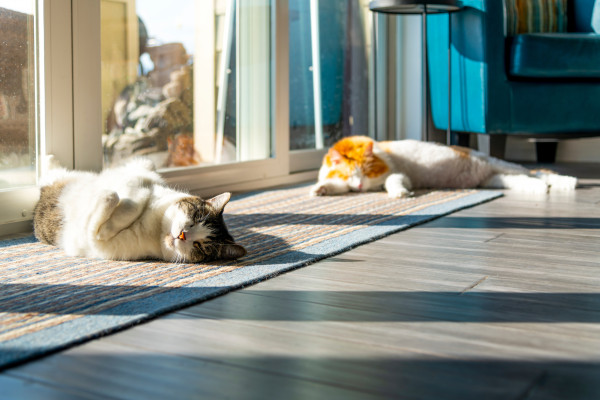 If you have more than one cat, if they are part of the same social group, they should be able to socialise and co-exist peacefully with each other. However, putting two or more cats who are not in the same social group into close proximity in an enclosed space with few options to create or maintain distance between them can cause significant stress, and even possibly lead to physical conflict. For more information on feline social groups and special considerations for multi-cat households, read on!
If you have more than one cat, if they are part of the same social group, they should be able to socialise and co-exist peacefully with each other. However, putting two or more cats who are not in the same social group into close proximity in an enclosed space with few options to create or maintain distance between them can cause significant stress, and even possibly lead to physical conflict. For more information on feline social groups and special considerations for multi-cat households, read on!
Feline social groups
If you have more than one cat living with you, each individual cat may either behave as a solitary cat or be part of a social group of cats. There may be more than one social group within the household. For example, if you have three cats, you may have one social group that consists of two cats and one cat who lives as a separate social entity, all within the same household.
When you have more than one cat in your family, social acceptance between the cats is not guaranteed, even if they are together from the beginning. Particularly when adding a new cat to a family with an existing cat (or cats), the new cat must be viewed and treated as a separate social entity/group from the existing cat(s), at least initially, although that may change if the existing cat(s) accept the new cat into their social group.
In multi-cat households, a lack of understanding of the number and make-up of the feline social groups and a failure to design the environment to accommodate these can result in cats not being able to easily access their essential resources, which can cause them stress, fear, anxiety, and frustration. Cats may block another cat’s access to resources (e.g., litter tray, cat flap, resting, or perching place), especially if they are unhappy about the other cat and their activities.
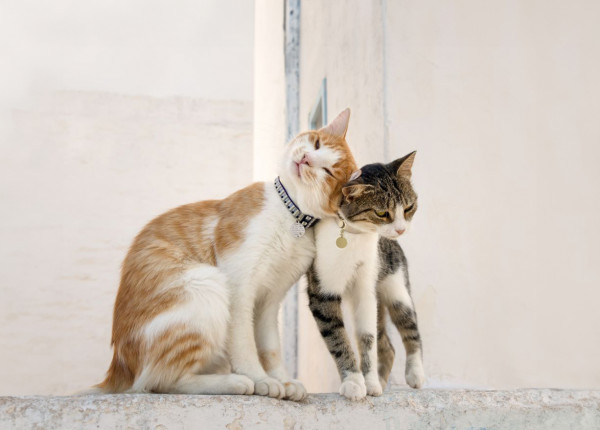
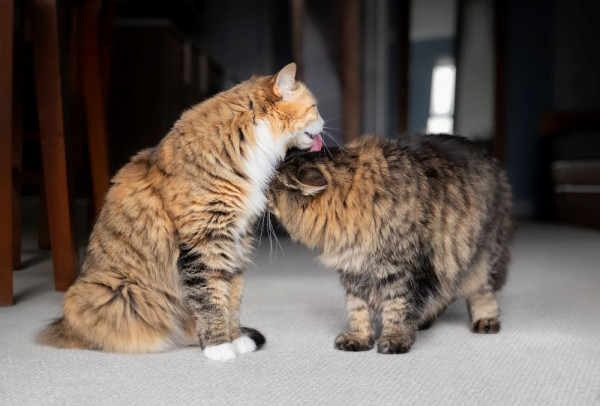

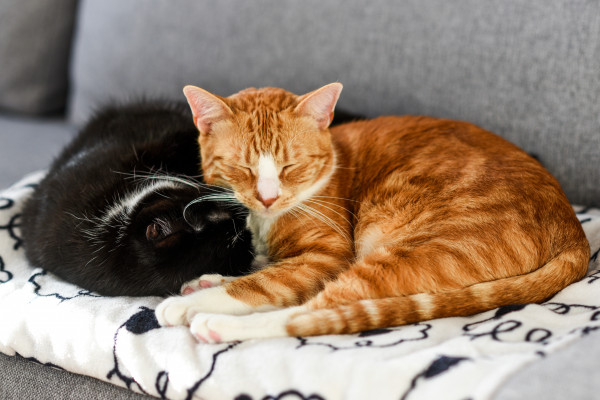
There are a number of clues that can help you understand the cat social groups in your household. Cats who are part of the same social group tend to display certain behaviours towards the other cats in their group, including allorubbing (rubbing their faces and bodies against the other cat), resting or sleeping in close proximity to the other cat, playing together, grooming each other (allogrooming), and tail wrapping. Cats not in the same social group do not show these behaviours towards each other.
It is important to understand the make-up of your feline household as you need to provide adequate physical separation of resources so there is no need for the cats to share the same areas to access the resources. Even within the same social group, each individual cat still needs their own resources within their social group’s area (e.g., litter trays and scratching posts). Ideally, and definitely if cats in the household are showing signs of stress or conflict, each social group should have a core territory of their own that is safe and secure, which cats from the other social groups cannot access.
The cats in the images to the right are showing behaviours indicating that they are part of the same social group (allorubbing, allogrooming, tail wrapping, and sleeping together).
Special considerations for multi-cat households
If you are wanting to have more than one feline family member, consider adopting two kittens who are littermates or adopting two cats together who are already bonded and get along well (these kitten/cat combinations may be more likely to get along and live happily together compared to kittens/cats who are not littermates or bonded cats).
Consider whether you can provide an environment that meets the physical and mental needs of more than one cat, as each cat needs multiple and separated resources immediately available to them at all times (e.g., food, water, toileting areas, scratching areas, play areas, and resting or sleeping areas).
If you do bring more than one feline into your life, make sure they are introduced in a way that maximises the chance of a successful and happy multi-cat home; but keep in mind that a harmonious multi-cat household is not guaranteed. All cats are individuals, and some love the company of other cats, but many others prefer to be on their own.
Having other cats living in the same space is often a significant cause of stress for cats. The impact of this can be minimised by providing each of them with multiple and separated essential resources, but there may still be tension between cats, and this can contribute to poor mental and physical wellbeing and unwanted behaviours like inappropriate toileting/spraying.
Another component of the feline home environment that is important to consider is whether all the cats in the household can access all the areas of their territory without being blocked by another cat. Having multiple entry and exit points to different areas can help minimise stress caused by cats blocking access to other cats. Although the design of a house with hallways, staircases, and doors makes it common to have only one entry/exit point, if this is an issue that is contributing to stress in a multi-cat household, it might be possible to overcome these issues by using the three-dimensional space of the house (e.g., with shelving to provide a ‘high road’ as well as the floor for a ‘low road’ or creating ‘hatches’ between rooms to act as an additional entry/exit point in addition to the door). If you have multiple cats and they have an outdoor area, making sure they have multiple entry and exit points to this is also important as cats can block another cat from using the cat flap if there is only one.
Understanding the feline social groups in your household will help you to better monitor for any subtle signs of conflict and adjust the environment to better support the wellbeing of the cats in your life.
Intercat tension
If you have more than one cat, it is important to be aware of signs of intercat tension and monitor carefully for these signs. The complexity of cat relationships and the potential for long term damage to these relationships and significant negative impacts from intercat tension on the wellbeing of all cats in the household mean that taking appropriate preventative steps (including providing an environment that meets the needs of all cats in the household), prompt recognition of intercat tension, and early and effective management are vital.
There are many situations that can trigger intercat tension, even if the cats have previously got along well. These include the addition of a new cat to the home, a change in home or family dynamic (e.g., moving house, redecoration/refurbishment of the home or a change in human or animal family members, including the death of a family member), other neighbourhood/outdoor cats in the vicinity (even if they cannot directly interact with your cats but your cats can see/smell/hear them), one or more cats with medical issues or pain, and veterinary visits. So, it is important to continually monitor your cats' interactions and behaviour and be aware of signs that might indicate tension.
Signs of intercat tension include (some signs can be quite subtle and easily missed or misinterpreted):
- Staring
- Chasing
- Stalking
- Fleeing
- Tail twitching
- Hissing
- Wailing or screaming
- Blocking
- Hiding
- Growling
- Biting
- Chasing
- Spitting
- Swiping
- Direct physical conflict (note that tufts of cat hair around the home can indicate that cats have had a physical conflict that people did not see).
When there is tension between cats, they may avoid one another but when this avoidance affects the ability or one or more cats to engage in important normal behaviours (like using the litter tray, eating, drinking, scratching, playing, interacting with people), this can be a problem even in the absence of overt signs of conflict.
For more information on intercat tension, including its recognition, prevention, and management please see the 2024 AAFP Intercat tension guidelines. These guidelines have a lot of helpful information, including photos and links to videos on how to recognise cat behaviour and body language indicative of intercat tension (and harmonious relationships) and how to differentiate physical conflict from play behaviours which can look quite similar sometimes.
If you think that your cats are displaying signs of intercat tension, please seek veterinary advice to discuss the situation, assess for medical conditions and pain, and make and implement a plan to help your cats.
Keeping me healthy
and happy at home
Have you provided everything I need?
While there are many benefits to keeping your cat at home, it also means that you have complete responsibility for, and control over, their environment. So, it’s essential that the spaces you provide meet your cat’s needs and provide opportunities for them to have positive experiences that will promote their wellbeing.
Meeting your cat’s environmental needs is essential for them to be as physically and mentally healthy as they can be. This includes ensuring that they have choice about where they eat, drink, rest, play, scratch, and toilet, and opportunities to engage in normal behaviours that are important to them like stalking, pouncing, climbing, scratching, hiding, retreating, and exploring. It’s vital to provide an optimal environment to minimise negative experiences and promote positive experiences for your cat, as well as to promote their good physical and mental health and wellbeing. Addressing these core needs can help reduce unwanted behaviour, and encourage safe, appropriate, and social behaviours.
The five pillars of a healthy feline environment:
This section is based on and adapted from the five pillars of a healthy feline environment framework from Ellis SL et al (2013) AAFP and ISFM feline environmental needs guidelines. Journal of Feline Medicine and Surgery 15(3):219-30 and Taylor S et al (2022) IFSM/AAFP Cat Friendly Veterinary Environment Guidelines. Journal of Feline Medicine and Surgery 24(11):1133-1163.
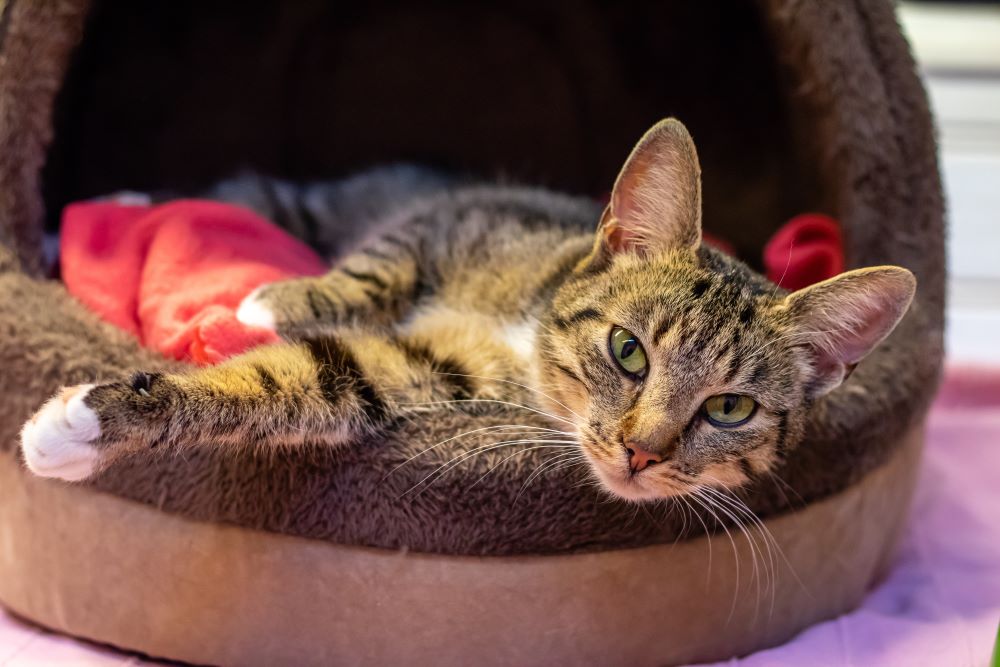
1. Provide a safe place
Why?
Cats need to have a choice of private, safe, and quiet places where they can retreat to help them feel secure, protected, happy, and in control. Cats are generally highly sensitive to potential threats and each individual cat will vary in what they perceive as threatening and their sensitivity to threats. Examples of what a cat might perceive as threatening are other animals or people who are unfamiliar or scary; loud or unusual noises; unfamiliar objects; and unfamiliar or unpleasant smells. Cats tend to want to avoid or evade threatening situations and so need to be able to retreat to a place where they feel safe and removed from whatever threat they perceive. Remember that the threat doesn't have to be real, immediate, and present to be perceived as a threat by the cat. For example, the cat may feel anxious about something that they think might happen, which is a negative experience for them, even if they are not in real danger.
It is vital that cat have places in their home where they can withdraw and feel safe, whenever they want to.
Cats particularly like to have elevated places from which they can observe the world but also feel secluded and safe; giving them elevated spaces also increases the area available to your cat by using more three-dimensional space in your home.
Note that kittens, older cats, and cats with physical disabilities, will need safe places they can access. This may mean providing safe places low down or accessible via ramps or stairs if they cannot climb or reach higher places.
How?
It’s important to offer cats observational, resting/sleeping, and hiding safe places.
Observational safe places
An observational perch or platform is somewhere that the cat can go to see what is happening in their surroundings but while feeling safe in their elevated space. This might be something like a shelf or platform that is elevated such as the top of a high cat scratching tree. Cats should have access to an observational perch or platform where they can see outdoors but feel hidden and secure.
Offering some attractive elevated spots to encourage jumping and climbing can also help to keep your cat active and healthy. You can make DIY modifications to your house and furniture to create multiple levels in your home, and/or buy cat furniture with different levels and surfaces (many also have a built-in hiding box). Any perches should be wide and long enough so that your cat can fully stretch out.
Resting/sleeping safe places
A resting/sleeping place should be a comfortable bed (open or covered) in a quiet safe area away from food, water, and toileting areas. Give your cat choices of open and covered areas to rest that are warm and comfortable, away from draughts, at a range of heights and easily accessible.
Hiding safe places
Cats need places where they can retreat and hide when they feel threatened or nervous.
Cats often like hiding in places like shelves, inside a wardrobe, in tunnels or boxes, or underneath a bed, so you can place cosy bedding in the places they like to give them an extra sense of relaxation and comfort. Just make sure that they cannot become trapped in that area accidentally (e.g., by the wardrobe being shut with them inside). 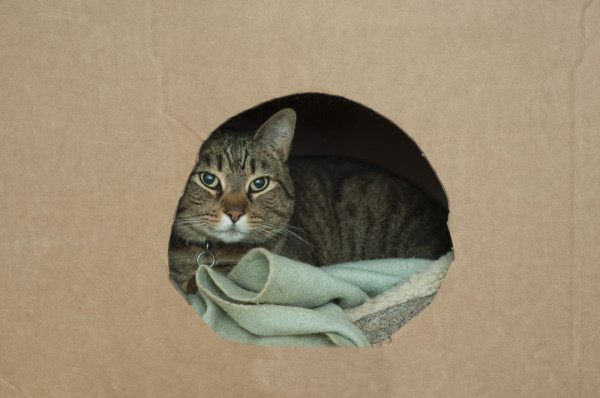
Other options for hiding places include a cat carrier left open and wooden, plastic, or cardboard boxes. Remember to make your cat’s safe places comfortable with soft bedding.
You should also provide hiding places that have more than one exit (so that if your cat is inside and feels threatened from one exit, they can retreat out the other rather than feeling trapped), this is especially important in multi-cat households.
Make sure that other, unfamiliar cats cannot enter your home and frighten or confront your cat. If you have a cat door that other cats can access, use a microchip activated cat door, so only your cat(s) can use it.
Reproduced here with kind permission from International Cat Care.
You might have noticed that cats tend to like warm environments – seeking out warm spots in the sun, near heaters, cosy ‘nests’ of bedding, igloos etc. They need to be able to express behaviours that help them regulate their own temperature (e.g., move from cooler to warmer areas or vice versa as needed). If we don’t give cats an environment where they can maintain a comfortable temperature (remembering that their comfortable temperature is a lot higher than for most people!), they can experience thermal discomfort. So, provide them with warm places like cosy bedding, warm igloos, or boxes with snuggly bedding; you can also use cat safe heat mats under some of their bedding to give them an even warmer option (a heat mat under an igloo provides a very warm and cosy resting and hiding place!). It is also important to make sure they can access cool areas such as tiles or shaded areas, so they can choose what temperature suits them best.
2. Provide multiple and separated key environmental resources
The essential resources that cats need include feeding and drinking stations, toileting areas, places to scratch, opportunities to play, and areas to sleep, rest, and hide.
Why?
Cats have an innate need to protect resources which are essential for their survival and so being able to access these in places that are safe and protected and away from perceived threats (such as other cats, other animals, busy areas, and people) is important. If cats have to access essential resources in places where they feel threatened and/or have to compete with other cats, this can result in stress which can have a significant negative impact on their mental and physical health.
How?
It’s critical to give your cat a variety of each of the essential resources, in multiple and separate locations for each resource (e.g., it is important that there are multiple feeding stations in separate locations and multiple drinking stations placed in separate locations away from the feeding stations). This provides cats with choice and control, minimises stress (and competition in multi-cat households), and provides opportunities for the cat to explore and be active as they move between resources.
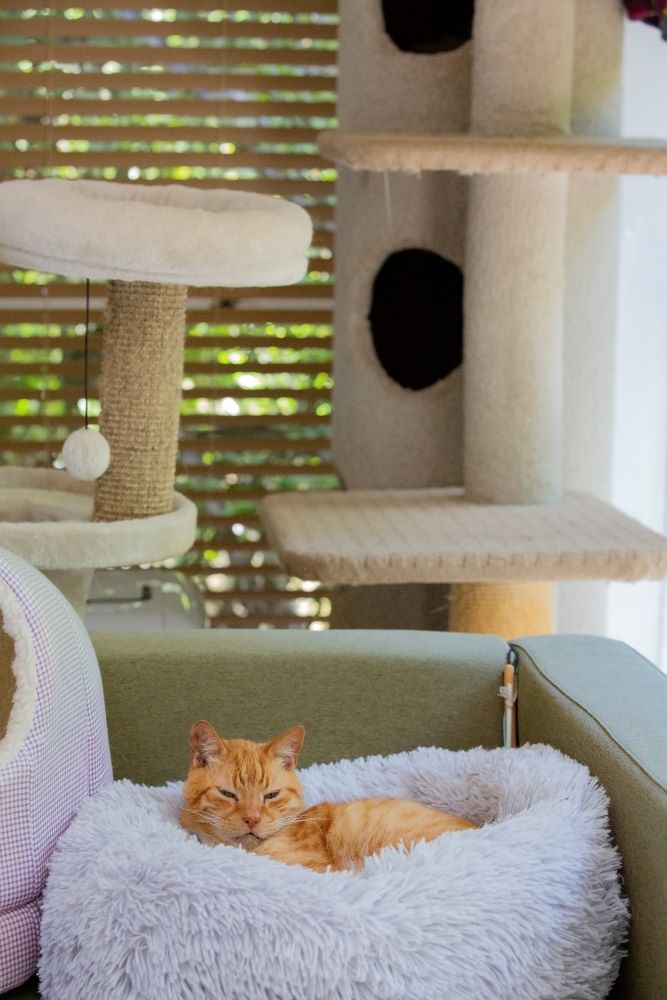
Checklist
To help create a safe and happy home for your cat, you need to offer them a variety of options (at least two choices for each resource in physically separated locations), then let your cat decide which ones they use, when, and how. As a guide, for one cat you will need at least the following, all in separate locations:
- 2 x litter trays
- 2 x feed stations
- 2 x water bowls
- 2 x play areas with a variety of toys for your cat to enjoy
- 3 x different types of scratching surfaces (vertical, horizontal, and different materials)
- 3 x resting/hiding places in different locations (elevated observation/perching points, elevated hiding and rest places, and comfortable beds in quiet private areas).
If you have more than one cat, you’ll need to provide more resources in more separate locations so each cat can access their own essential resources whenever they want, without navigating interactions with other cats which can be stressful. You can find more information here about multi-cat households and the special considerations involved.
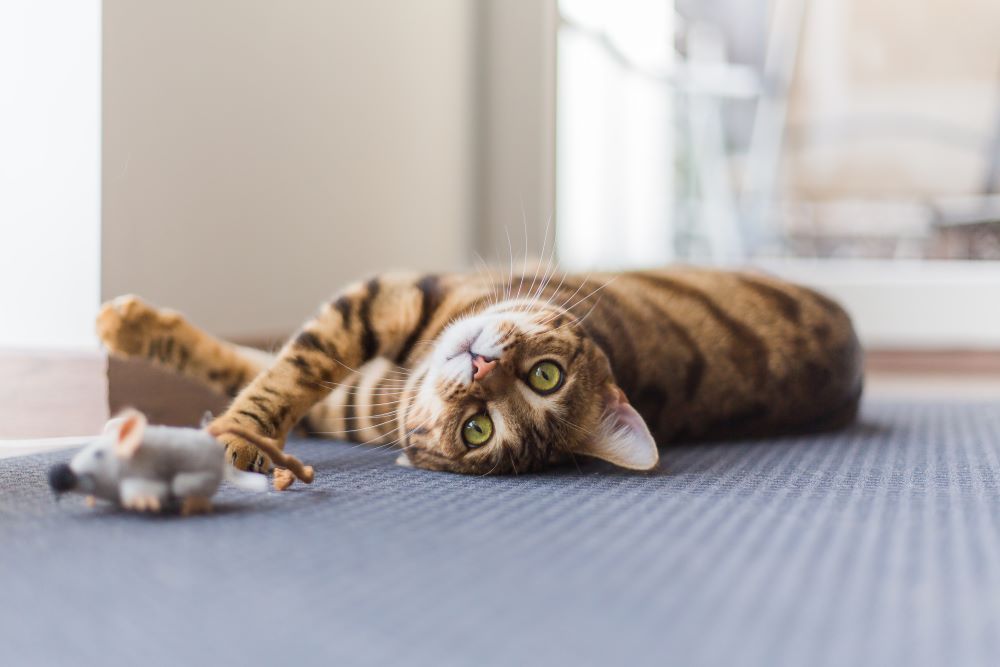
3. Provide opportunity for play and predatory behaviour
Why?
Cats have a strong innate need to engage in behaviours which are part of the act of capturing prey. The sequence of behaviours involved includes finding, capturing (including stalking, chasing, pouncing, and grabbing), dispatching, and consuming their prey. Although we want to avoid our cats preying on live animals, we still want to provide them with opportunities to express these important natural behaviours. The good news is that these behaviours can be stimulated by predatory play with toys and food. It is important to ensure that cats can display these natural behaviours that would take up a significant portion of a wild cat’s time and stimulate them mentally and physically, otherwise cats can become bored and frustrated and may also be physically inactive leading to health problems such as obesity.
How?
Here are some ideas for how you can help encourage your cat to express their natural predatory behaviour using food and toys.
Reproduced here with kind permission from International Cat Care.
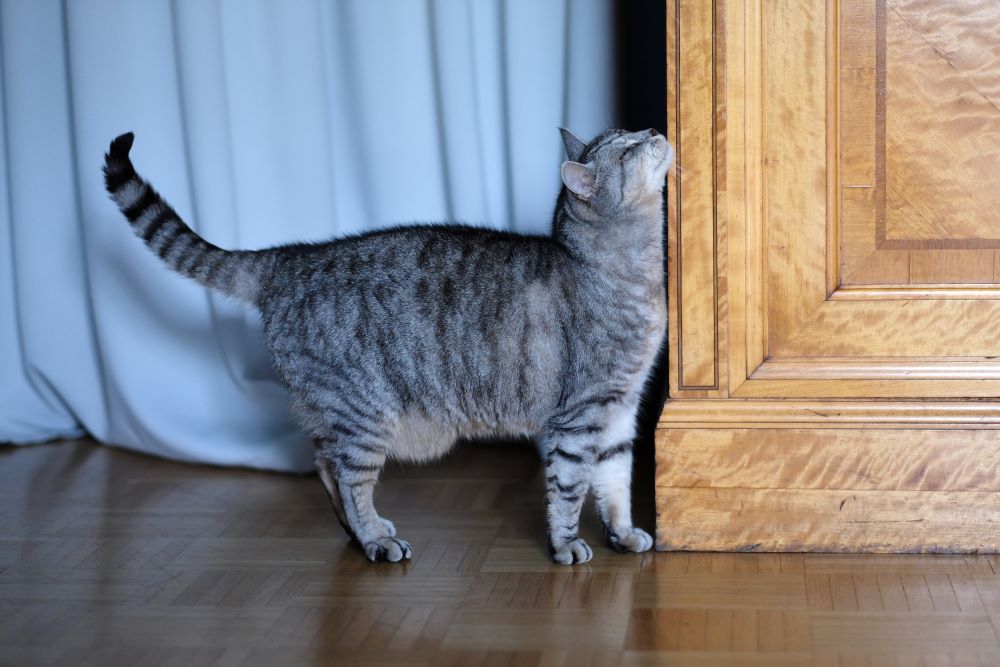
5. Provide an environment that respects the cat’s sense of smell and other senses
Why?
Cats use information gained through all of their senses as an important way to assess their environment. This includes assessing the environment for threats, communicating with other cats (and other animals and humans), searching for food, and more!
Reproduced here with kind permission from International Cat Care.
The physical environment, other animals, and people will all have impacts on a cat’s senses (smell, sight, hearing, touch, and taste). The impacts can be positive (e.g., leading to the cat experiencing emotions like pleasure, engagement, calmness, and comfort) or negative (e.g., leading to the cat experiencing emotions like fear, frustration, and anxiety). These potential impacts should be considered when creating and sharing a cat friendly home, including when interacting with cats.
Smell
Cats have a much more sensitive sense of smell than people, and it is important to consider how the smells in your home might impact them. Cats sense smells via their nose and also special chemical signals (pheromones) detected by a specialised organ in the hard palate, called the vomeronasal organ. As well as gathering information in these ways, cats also leave scent and pheromones around their territory to help them communicate with other cats and create a sense of environmental familiarity and security for themselves.
Cats mark the boundaries of the area they consider their core home territory as familiar and secure by leaving scent and pheromones. They do this through rubbing special areas of their face and body on surfaces such as furniture, doorways, walls, and corners – signalling to other cats and reassuring themselves that this is their home. As well as rubbing, cats also deposit scent when they scratch as they have scent glands around their paw pads.
Cats depend on their sense of smell, and it also serves as an important form of communication for them. A cat’s sense of smell is essential to their sense of home and security. It is important that people respect this feline need to mark their territory and avoid interfering with or removing these scent deposits. In addition, it is very upsetting to cats if scents are introduced into their home environment that they find threatening (e.g., the scent of an unfamiliar cat or a smell they find unpleasant like citrus). Not allowing cats to scent mark, removing their scent, and introducing threatening scents can cause stress and confusion to your cat and negatively impact their wellbeing. This can also potentially result in stress-related scent marking (such as urine spraying) or stress related health problems (such as lower urinary tract disease).
How?
Ensuring a ‘safe’ scent environment will help your cat to feel safe and secure, and this positively affects their health and happiness.
Reproduced here with kind permission from International Cat Care.
Sight
Cats may be frightened or frustrated by the sight of unfamiliar animals and people, and those who they dislike or find scary.
Think about the impact of things your cat may see and take steps to avoid or minimise potentially frightening or frustrating sights. For example, avoid bringing an unfamiliar dog where your cat can see them, if it can be avoided. If it cannot be avoided, make sure the cat has a safe and secure place to retreat to where they can hide from the frightening sight. Avoid putting your cat in a situation where sights may cause them to be frustrated. For example, attracting birds to a window where the cat can see them but not get at them may be intensely frustrating for some cats (not to mention frightening for the birds), and so should be avoided.
If your cat becomes stressed or frightened by sights outside of the home (e.g., an unfamiliar or frightening cat outside the window), it may be helpful to your cat to block visual access (e.g., add temporary frosting to glass over at least part of the lower area of the window) so your cat can choose not to see the feared sight and always make sure they have access to safe hiding places. See also “Privacy from the outside” under 1. Provide a safe place.
Keep in mind the potential for unfamiliar sights to scare your cat when taking your cat away from their home (e.g., to the veterinarian). Make sure they have the choice to hide, even just in their cat carrier. For example, cover part of their carrier with a towel so they can retreat and hide if they are afraid. It is important to get your cat used to going into and being moved in their carrier. This will help minimise fear and anxiety when you do need to take them somewhere. You can find more information on cat carrier training here “Getting your cat used to their carrier as a safe space” under 1. Provide a safe place.
Also, think about how you and other people interact with and approach your cat – looming over them, staring at them, or allowing unfamiliar people to directly approach them may be intimidating or frightening and should be avoided. For more information see 4. Provide positive, consistent, and predictable human-cat social interaction.
Sights can be positive too! For example, the sight and movement of a favoured toy can stimulate engagement and enjoyable play, and the sight of a familiar and liked person can be associated with comfort and pleasure.
Hearing
Cats have very sensitive hearing and can rotate their ears very precisely to pinpoint sounds. They may be frightened by unfamiliar, loud, or unpleasant noises, so keep this in mind and try to avoid or minimise any potentially frightening sounds in their home. Ensure that they always have a quiet and peaceful place they can retreat to if things get a bit noisy or just too much for them.
Touch
Comforting, gentle, and pleasant touch can be a positive experience for cats; for example, when the cat initiates an interaction with you, and you stroke them around their face and ears in a way that they enjoy. Never force touch on your cat and do not handle or touch them roughly or in a way they don’t like as this will be an unpleasant experience for the cat and they may feel frightened, anxious, annoyed, or uncomfortable. Each cat is an individual, so learn how your cat likes to be touched, and what they don’t like. For more information see 4. Positive, consistent, and predictable human-cat social interaction.
Remember that cats’ whiskers are very sensitive. Some cats may find contact of their whiskers with the sides of a water or food bowl unpleasant. It is a good idea to have wide mouthed water bowls for your cats, so their whiskers do not touch the sides. Feeding your cats using food toys and systems that do not involve a bowl or use a wide mouthed bowl or flat surface for feeding them, are also good options.
Cats should have a variety of surfaces that feel different to their sensitive paws to choose from – for example, cool smooth surfaces (e.g., tiles), soft warm surfaces (e.g., bedding), and pleasantly rough surfaces to scratch on (e.g., scratching posts).
Taste
You can use your cat’s sense of taste to provide them with opportunities for positive experiences, such as giving them a variety of tasty foods and treats that they enjoy (end you can use these for food-based stimulation, play, and training too!). You can also use tastes your cat enjoys to help you entice them to where you want or need them to be (e.g., into their carrier or into another room). You can lay a “food trail” or encourage them to follow a treat held in your hand (a tube or sachet of treat paste or a piece of cooked meat works well for this and utilises their sense of smell too!).
Potential unwanted behaviours
If you’ve followed this advice so far, you should be on the right track for a happy and healthy future with your cat. But things don’t always go according to plan, especially when cats are entering a new home.
Cats who are experiencing emotions such as fear, anxiety, and frustration may be more likely to display behaviours such as toileting in inappropriate places or being confrontational towards other cats or humans. These behaviours are more likely to develop if your cat has not been provided with opportunities to express their individual interests. Identifying ways to offer them more choice and control in their environment and interactions with people and other animals can help to improve their emotional state and reduce any unwanted behaviours (see the section above on the five pillars of a healthy feline environment for more information).
As a first step, carefully check that you’ve covered all the points we’ve outlined here and that your cat has an interesting and stimulating environment and choices about where and how they feed, drink, rest, hide, scratch, toilet, play, and interact with people, other animals, and their environment. Observe your cat to see how and where they spend their time and what choices they make. If you have more than one cat, carefully observe their behaviours and interactions with each other for information about their social group and potential conflict. If there is anything that you could improve, then change this straight away. An example might include additional litter trays or water bowls in different physically separated locations to reduce competition between individuals for access to these important resources. If you have a dog, you might consider using a toddler safety gate that cats can jump over or get through to provide an area that dogs cannot go within the house. If problems persist, you should seek advice as soon as possible from your veterinarian and/or a qualified veterinary behaviourist (make sure that only reward-based training is used).
At the end of the day, we all want our cats to have a happy and healthy life with us. Part of this is learning to understand why your cat might behave the way they do - if it's a result of their environment, the emotions they're experiencing, or if it's just the way your cats are as individuals! Cats don't always behave in the way we want them to, so if our cat is displaying unwanted behaviours, it's important to work out if they're trying to tell us something. There is probably something we can change/improve to reduce or redirect the behaviour by offering them more potential for positive mental experiences. It might be something we need to learn to live alongside, but there is a lot that can be done to help promote harmonious relationships and safe interactions. Our guide to understanding cat behaviour can help you to learn more.

